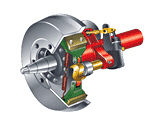True/False
Indicate whether the
statement is true or false.
|
|
|
1.
|
“Stab braking” during an emergency means applying your brakes all
the way until wheels lock up, then releasing until the wheels start rolling, then repeating as
necessary.
|
|
|
2.
|
Air brakes are faster than hydraulic brakes because air moves faster than
hydraulic fluid.
|
|
|
3.
|
If you are going to be away from your vehicle for only a short period of time,
you do not need to set the parking brake.
|
|
|
4.
|
If your vehicle has an alcohol evaporator, you should check and fill the alcohol
level daily in cold weather.
|
|
|
5.
|
The following picture is an S-cam air brake drum: 
|
|
|
6.
|
The brake pedal used by a driver applies and releases the service brakes.
|
|
|
7.
|
Vehicles that have manual drains on air tanks must be drained at the end of each
day.
|
|
|
8.
|
Vehicles with antilock braking systems (ABS) have yellow malfunction lamps to
tell the driver if something is wrong.
|
|
|
9.
|
Total stopping distance for air brakes is longer than hydraulic brakes due to
“brake lag” in air brakes.
|
|
|
10.
|
When a low pressure warning device comes on, you have up to an hour before you
have to stop.
|
Multiple Choice
Identify the
choice that best completes the statement or answers the question.
|
|
|
11.
|
The most common type of foundation brake found on heavy trucks is
the:
a. | Disc brake. | b. | Wedge drum brake. | c. | S-cam drum
brake. | d. | Engine brake. |
|
|
|
12.
|
On a heavy truck, the _____________ brake system is what applies and releases
the brakes when the driver presses the brake pedal during normal operation.
a. | Parking. | b. | Service. | c. | Drum. | d. | Secondary. |
|
|
|
13.
|
Before driving a vehicle with a dual air system, a driver must allow time for
the air compressor to build up a minimum of ________ psi air pressure in both the primary and
secondary systems.
|
|
|
14.
|
To make sure the spring brakes come on automatically on a tractor
trailer, pump the brakes to reduce the air pressure until the tractor protection valve and parking
brake valve close (pop out) when the air pressure falls to the manufacturer’s specifications,
which are between _____ and _____ psi.
a. | 10-20 | b. | 20-30 | c. | 20-40 | d. | 40-50 |
|
|
|
15.
|
When testing a combination vehicle air brake system for leaks, with the
engine off and the brakes released, the system should not leak at a rate of more than ______ psi per
minute.
|
|
|
16.
|
The air compressor governor controls:
a. | The air that flows to the air pressure gauge. | b. | The air pressure
applied to the brake drums. | c. | When air is pumped into the air storage
tanks. | d. | The release of air pressure from the brake chambers. |
|
|
|
17.
|
The application pressure gauge tells you how much air pressure:
a. | You have used so far. | b. | Is contained in the air storage
tanks. | c. | Is in the tires. | d. | You are applying to the
brakes. |
|
|
|
18.
|
What factors can cause brakes to fade or fail?
a. | Brakes out of adjustment. | b. | Excessive use of the service
brakes. | c. | Expansion of the brake drums caused by overheating. | d. | All of the
above. |
|
|
|
19.
|
You know your brakes are fading when:
a. | The brake heat warning lamp comes on. | b. | You release the brake pedal and speed continues
to increase. | c. | Harder than normal pressure on the brake pedal is needed to control speed on a
downhill grade. |
|
|
|
20.
|
If your vehicle does not have automatic drains for the compressed air storage
tank, how often should you drain the oil and water from your tanks?
a. | Once a week. | b. | At the end of each day. | c. | Monthly. | d. | Only when inspected by a state or federal
official. |
|